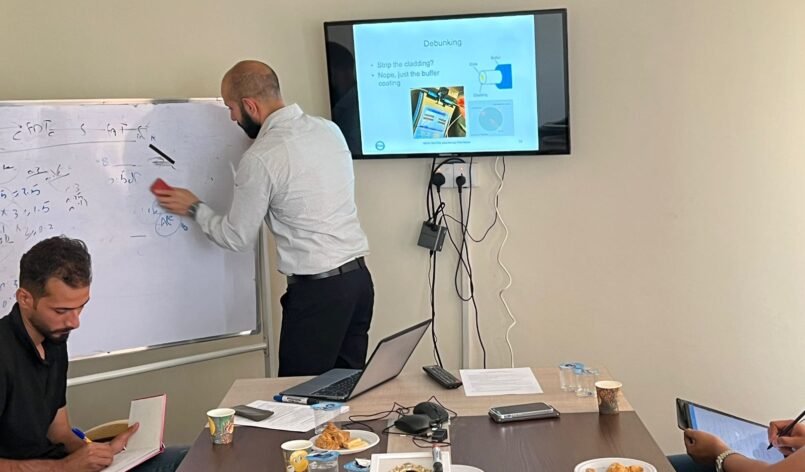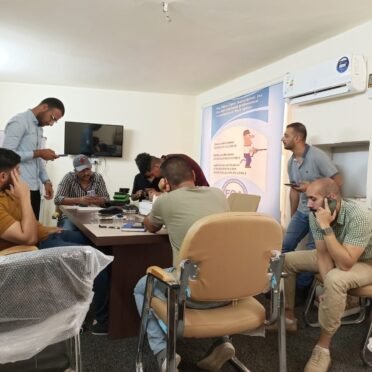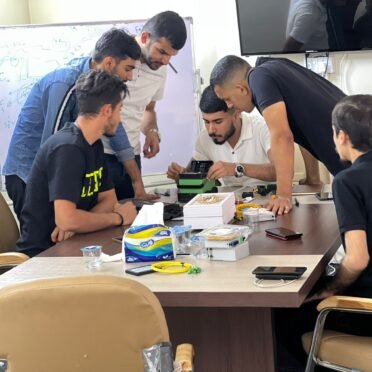
FOA-Lesson Plan
Objectives: From this lesson you should learn:
- What does “fiber optics” mean
- How fiber was developed and used in communications
- The difference between “outside plant” and “premises” fiber optics
- Some advantages of fiber optics
- What standards cover fiber optics
- How to work with fiber safely
Why AFAK
Award Winning
Lesson 1: Introduction, Overview, Standards, Safety
Introduction
That Bell Labs photo from the infancy of fiber optics was used to illustrate that one tiny optical fiber could carry more communications signals than a giant copper cable.
Today one singlemode fiber could carry the same amount of communications as 1000 of those old copper cables! Fiber offers thousands of times more bandwidth than copper cables and can go more than 1000 times further before needing repeaters – both of which contribute to the immense economic advantage of fiber optics over copper.
You can do a similar analysis for using wireless transmission also, but wireless is limited by the available wireless spectrum which is overcrowded because of everyone’s desire to use more mobile devices.
Fiber’s advantages has led to its use as the backbone of all of today’s communications, telecom, Internet, CATV, etc. – even wireless where towers are connected on fiber and antennas are using fiber up the towers too.
What is “Fiber Optics”?
Fiber optics refers to the technology of transmitting light down thin strands of highly transparent optical fibers, usually glass but sometimes plastic.
Fiber optics is used in communications, lighting, medicine, optical inspections and to make sensors.
The FOA is primarily interested in communications fiber optics, so this lesson will focus on that aspect of its application. In addition, you will be introduced to international standards for fiber optic components and systems.
And finally, we want to start making you aware of the safety aspects of dealing with fiber optics because it is extremely important to understand what it takes to work safely with fiber.
This lesson has two primary aims, to familiarize you with the applications of fiber optics and a bit of its history and to make you aware of the safety aspects (including some of the most famous myths of fiber optics.)
Lesson 2: Fiber Optic Jargon
Objectives: From this lesson you should learn:
The language of fiber optics Systems of measurements used in fiber optics Specialized fiber optic terms The key to understanding any technology is understanding the language of the technology — the jargon.
We’ve started the website and book with an overview of fiber jargon to introduce you to the language of fiber optics and help you understand what you will be reading in the lessons.
We suggest you read this section first to help
Lesson 3: Fiber Optic Communications
Objectives: From this lesson you should learn:
The advantages of optical fiber as a communications medium How optical fiber is used in communications systems Other uses for fiber optics Why use fiber? Fiber has become the communications medium of choice for telephones, cell phones, CATV, LAN backbones, security cameras, industrial networks, just about every kind of communications – now even all the way to the home.
In this lesson, you will learn why fiber is the medium of choice for most communications networks and how many of those networks use fiber.
Lesson 4: Fiber Optic Transmission Systems And Components
Objectives:
From this lesson you should learn: How fiber optic data links and transmission systems work What components are used in transceivers Types of sources and detectors used in transceivers Performance parameters of fiber optic transmission systems Fiber optic transmission systems use datalinks that consists of a transmitter on one end of a fiber and a receiver on the other end.
Most systems operate by transmitting in one direction on one fiber and in the reverse direction on another fiber for full duplex operation.
A FTTH passive optical network (PON) is one of the few systems using bidirectional transmission over a single fiber because its network architecture is based around couplers already.
Datalinks can be analog or digital, depending on the information being transmitted.
In this lesson you will learn how fiber optic systems transmit data.
Lesson 5: Optical Fiber
Objectives:
From this lesson you should learn: What is Optical Fiber? How optical fiber transmits light Types of fiber Physical characteristics of various types of fibers Fiber performance specifications In this lesson you will learn what optical fiber is, how it transmits light and all the types of fiber available.
Optical fiber is the communications medium that works by sending optical (light) signals down extremely pure hair-thin strands of glass or plastic fiber.
The light is “guided” down the center of the fiber which is called the “core”.
The core is surrounded by a optical material called the “cladding” that traps the light in the core using an optical technique called “total internal reflection.
” The fiber itself is coated by a “buffer” to protect the fiber from moisture and physical damage.
Notes (IMPORTANT):
The buffer is what one strips off the fiber for termination or splicing.
Fiber is specified by size (core/cladding) and core design which determines whether it is multimode or singlemode and its performance parameters. This lesson will cover all those topics.
Fiber Trivia: Although glass optical fibers are made of a material that everyone assumes is weak and fragile, it’s made from ultra pure glass and is actually quite flexible, 3 times stronger than steel and 6 times stronger than titanium (according to the largest manufacturer of optical fiber, Corning.)
Lesson 6: Fiber Optic Cable
Objectives:
From this lesson you should learn: The types of fiber optic cables and their applications Differences between outside plant and premises cables Specifications for fiber optic cables Fiber Optic Cable Design This lesson covers cables.
Fiber optic cable provides protection for the optical fiber or fibers within it appropriate for the environment in which it is to be installed.
Cable refers to the complete assembly of fibers, strength members and jacket.
Fiber optic cables come in many different types, depending on the number of fibers and how and where it will be installed.
It is important to choose cable carefully as the choice will affect how easy the cable is to install, splice or terminate, what it will cost and how long it will last in the field.
Lesson 7: Termination and Splicing
Objectives:
From this lesson you should learn: The difference between connectors and splices Requirements for connectors and splices Connector styles Termination types of connectors Splice types Splicing procedures Connectors or Splices? In this lesson, a long and very important one, you will learn about fiber splicing and termination.
Fiber optic joints or terminations are made two ways: 1) connectors that mate two fibers to create a temporary joint, patch between two cables and/or connect the fiber to a piece of network gear or 2) splices which create a permanent joint between the two fibers.
Either termination method must have two primary characteristics: good optical performance indicated by low loss minimal reflectance and high reliability.
Terminations must also be of the right style to be compatible to the equipment involved and be protected against the environment in which they are installed.
Lesson 8: Fiber Optic Testing
Objectives:
From this lesson you should learn:
What parameters need to be tested
What instruments are used for fiber optic testing
How to perform basic fiber optic testing
Measurement uncertainty in fiber optic testing
How to troubleshoot problems
Fiber Optic Tests
This lesson, another extensive one, is on fiber optic testing. Testing is the most complex part of fiber optics but one of the most important.
After all fiber optic cables are installed, spliced and terminated, they must be tested.
For every fiber optic cable plant, you need to test for continuity and polarity, end-to-end insertion loss and then troubleshoot any problems on every fiber in every cable.
If it’s a long outside plant cable with intermediate splices, you will probably want to verify the individual splices with an OTDR test also, since that’s the only way to ensure that each splice is good.
If you are the network user, you may also be interested in testing transmitter and receiver power, as power is the measurement that tells you whether the system is operating properly.
Testing involves visual inspection of terminations with a microscope, tracing fibers visually and finding faults, measuring optical power and loss with power meters and light sources and sometimes specialized testing with OTDRs and testers for special issues in long distance links.
With this lesson, it’s important to learn what needs testing and why, what are the potential errors involved in the tests and where certain tests are appropriate.
For example, all installed cable plants require insertion loss testing but some may also need OTDR tests, but OTDR tests are generally not appropriate for short cables and always require a knowledgeable operator to interpret traces – they are not “push button” testers! Testing gives you data – in this case the loss of the fiber in a cable plant.
But does that test data tell you the cable plant loss is good (low enough) or bad (loss is too high)? You need to know that to pass or fail any fiber being tested. The way you estimate the loss of the cable plant is to calculate a “loss budget” for the fibers in a cable plant.
Generally the loss budget is done during the design phase of a project and the data used to validate the design for use with communications equipment.
But that same data should be used by the installer/tester to compare to test results and make the pass/fail judgement.
Lesson 9: Fiber Optic Network Design
Objectives:
From this lesson you should learn:
What Is Fiber Optic Network Design?
What is involved in fiber optic network design
What a designer needs to know
How a project develops from idea to installation
How to choose equipment and components for the network
How to create a loss budget for the design
How to plan for and complete an installation
This lesson will help you learn the process of designing a fiber optic network. Not everyone will design a fiber optic network, but understanding the process will make installing, testing and documenting a network easier.
Fiber optic network design refers to the specialized processes leading to a successful installation and operation of a fiber optic network. It includes determining the type of communication system(s) which will be carried over the network, the geographic layout (premises, campus, outside plant (OSP, etc.), the transmission equipment required and the fiber network over which it will operate.
Designing a fiber optic network usually also requires interfacing to other networks which may be connected over copper cabling and wireless. Next to consider are requirements for permits, easements, permissions and inspections. Once we get to that stage, we can consider actual component selection, placement, installation practices, testing, troubleshooting and network equipment installation and startup. Finally, we have to consider documentation, maintenance and planning for restoration in event of a future outage.
The design of the network must precede not only the installation itself, but it must be completed to estimate the cost of the project and, for the contractor, bid on the job. Design not only affects the technical aspects of the installation, but the business aspects also.
Lecture 10, Fiber Optic Installation
Objectives:
From this lesson you should learn:
What is involved in a fiber optic installation
The role of the contractor and installer
How to prepare for the installation
What is involved in the installation process
How to verify the quality of the installation
Safety for fiber optic installations
Your final lesson covers fiber optic installation. After the process of designing fiber optic networks is completed, the next step is to install it. What do we mean by the “installation process?” Assuming the design is completed, we’re looking at the process of physically installing and completing the network, turning the design into an operating system.
This is a more complex process than it may seem at first. This lesson covers preparing for the installation, requirements for training and safety and then the actual installation process. The video lecture on Cabling Project Management discusses the process of building a network, and we recommend the video to get an overview of the process.

FTTx Training Course
FTTx Training Course



